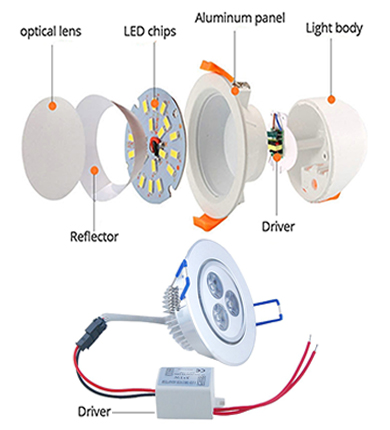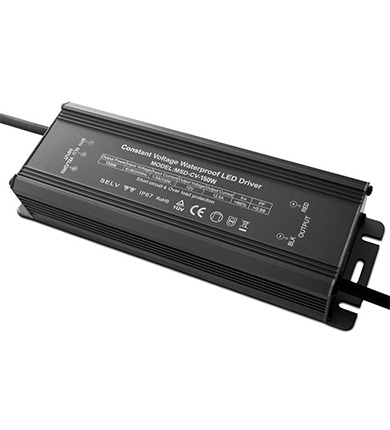
What is the LED lighting driver?
Two Main types of LED Driver
Lighting Solutions are developed over time. In the past, most traditional lightings need a Ballast to operate. In comparing with LED technology which needs a Led Driver to obtain the right voltage and current for the source of light (LED Chip).
What is the LED Driver?
It is an electronic device which regulates the power required for an LED or array of LEDs.
Its main purpose is to rectify higher voltage alternating current (AC) to low voltage direct current (DC). (AC / DC adapter) required to operate the source of light (LED Chip).

Do All LED Lights Need a Driver?
Yes, all LED lights do require a driver to operate.
- Some models are supplied with an
integrated driver as we can find in interior lighting items ( track light, wall light) or outdoor lighting (step lights, bollard lights),
and other where drivers come as
separate component which could be hided in false ceiling such as spot lights and down lights.

Two main types of LED driver:
| Constant Voltage | Constant Current | |
| Redefine | CV Power Supply |
CC |
| Configuration | Convert the incoming mains voltage of AC to constant lower DC voltage and regulate the current. | Convert the incoming mains voltage of AC to lower DC voltage with constant current output |
| Output | Provides a fixed output voltage and LEDs are connected parallel with the driver. | Provides a fixed output current and LEDs connected in series. |
| Application | It is ideal for powering LED strip and external lighting to deal with low voltages for safety. | CC drivers are often the most popular choice such as, downlights, spot light, panel light for retail and hospitality applications. |
How to choose the right LED driver?
There are many considerations for choosing your LED driver, so we will mention the most important factors:

1. Output Power (W)
You need to choose a driver that provides at least the power requirement of your LEDs. It is better to have a higher output power than your LEDs require for extra safety.
For example, if we have 40 m length of Serpent strips (9.6W/m)

2. Output Voltage (V) / Output Current (A)
- Output Voltage (V):
a) Constant Voltage: The output voltage of the driver needs to match the voltage required by the LEDs. For example, we have Maknoon Neon flex with Voltage DC 24V. We need driver with Output Voltage 24 V.
b) Constant Current: The output voltage must exceed the LED requirements.
- Output Current (A): LEDs can be run at a lower current to help extend its life expectancy. Using a higher current could damage the LED quicker.
a) Constant Voltage: The current limiters for driver must be within LED Current to operate.
b) Constant Current: If your LED needs 350 mA your driver needs to have that output too.

3. Power factor
Describes how efficiently an LED driver uses electricity. The range for power factor is a decimal between [0,1]. The closer to 1 the power factor is, the more efficient the driver is.
4. IP Rating
To fit different applications: Indoor applications (IP20) or Outdoor (IP65 and higher).
5. Dimming
If you want to be able to dim your LEDs be sure to buy a driver with dimming capabilities. If you don’t need dimming, a normal (ON / OFF) driver is enough for you. If you need dimming:
a) Analog: Phase cut Dimming, Leading & Trailing Edge, 1-10 V & 0-10V
b) Digital: DALI Driver, DMX.

In this article : power supply driver, phase cut dimming, constant voltage, led driver, power supply, constant current, ac dc adapter, driver led, adapter ac dc, led ballast, driver dimmer led, led transformer, dali driver, transformator led driver, driver chip led, electronic transformer for led lights, dimmable led light driver, constant current driver, constant current led driver, led tube light driver, led driver chip, led driver module, constant current led driver circuit, lamp driver, driver downlight led, compact led driver, led driver light fixture, constant current dimmer, constant current led driver dimmable, constant voltage led, constant voltage led power supply, led driver power supply transformer, driver in lighting, led light bulb ballast, constant current and constant voltage power supply, choosing led driver, constant current led driver chip, ballast in led lights, phase dimming driver, lighting driver, dimmable, non dimmable, dimmable power supply, dali dimmable, dimming dali, led driver ballast, led driver components, led lamp driver
